2001 YAMAHA XJ900S brake light
[x] Cancel search: brake lightPage 13 of 100

DESCRIPTION
2-2
2
Right view8. Tail/brake light
9. Fuse boxes (page 6-29)
10. Seat (page 3-11)
11. Owner’s tool kit (page 6-1)
12. Air filter element (page 6-13)13. Front fork spring preload
adjusting bolt (page 3-13)
14. Engine oil level check window (page 6-8)
15. Brake pedal (page 3-8)
E_4km.book Page 2 Thursday, September 7, 2000 9:32 AM
Page 15 of 100

3
INSTRUMENT AND CONTROL FUNCTIONS
Main switch/steering lock ..................................... 3-1
Indicator and warning lights ................................ 3-2
Speedometer unit ................................................ 3-3
Tachometer .......................................................... 3-4
Self-diagnosis device ........................................... 3-4
Anti-theft alarm (optional) .................................... 3-5
Fuel gauge ........................................................... 3-5
Clock .................................................................... 3-5
Handlebar switches ............................................. 3-6
Clutch lever .......................................................... 3-7
Shift pedal ............................................................ 3-8
Brake lever .......................................................... 3-8Brake pedal ......................................................... 3-8
Fuel tank cap ...................................................... 3-9
Fuel ..................................................................... 3-9
Fuel tank breather hose (for Germany only) ..... 3-10
Starter (choke) lever .......................................... 3-10
Seat ................................................................... 3-11
Helmet holder .................................................... 3-11
Storage compartment ....................................... 3-12
Adjusting the front fork ...................................... 3-13
Adjusting the shock absorber assembly ............ 3-13
Sidestand .......................................................... 3-15
Ignition circuit cut-off system ............................. 3-15
E_4km.book Page 1 Thursday, September 7, 2000 9:32 AM
Page 35 of 100

PRE-OPERATION CHECKS
4-2
4
NOTE:@ Pre-operation checks should be made each time the motorcycle is used. Such an inspection can be accomplished in a very
short time; and the added safety it assures is more than worth the time involved. @
EWA00033
WARNING
@ If any item in the Pre-operation check list is not working properly, have it inspected and repaired before operating
the motorcycle. @Wheels and tires• Check for damage.
• Check tire condition and tread depth.
• Check air pressure.
• Correct if necessary.6-17–6-20
Brake and shift pedals• Make sure that operation is smooth.
• Lubricate pedal pivoting points if necessary.6-24
Brake and clutch levers• Make sure that operation is smooth.
• Lubricate lever pivoting points if necessary.6-24
Centerstand, sidestand• Make sure that operation is smooth.
• Lubricate pivots if necessary.6-25
Chassis fasteners• Make sure that all nuts, bolts and screws are properly tightened.
• Tighten if necessary.—
Instruments, lights, signals
and switches• Check operation.
• Correct if necessary.—
Sidestand switch• Check operation of ignition circuit cut-off system.
• If system is defective, have Yamaha dealer check vehicle.3-15 ITEM CHECKS PAGE
E_4km.book Page 2 Thursday, September 7, 2000 9:32 AM
Page 43 of 100
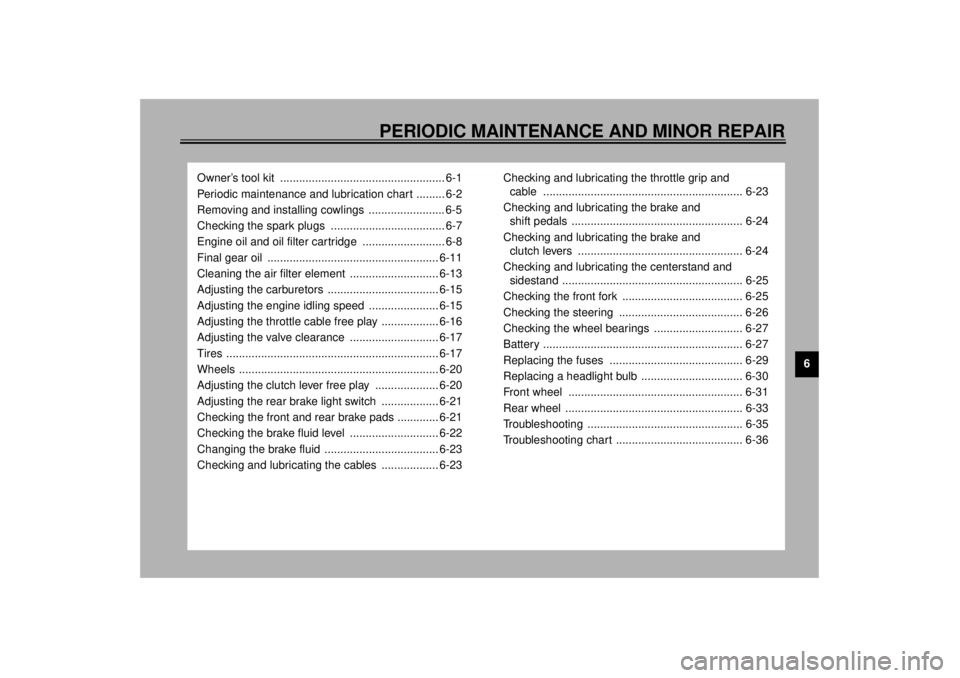
6
PERIODIC MAINTENANCE AND MINOR REPAIR
Owner’s tool kit .................................................... 6-1
Periodic maintenance and lubrication chart ......... 6-2
Removing and installing cowlings ........................ 6-5
Checking the spark plugs .................................... 6-7
Engine oil and oil filter cartridge .......................... 6-8
Final gear oil ...................................................... 6-11
Cleaning the air filter element ............................ 6-13
Adjusting the carburetors ................................... 6-15
Adjusting the engine idling speed ...................... 6-15
Adjusting the throttle cable free play .................. 6-16
Adjusting the valve clearance ............................ 6-17
Tires ................................................................... 6-17
Wheels ............................................................... 6-20
Adjusting the clutch lever free play .................... 6-20
Adjusting the rear brake light switch .................. 6-21
Checking the front and rear brake pads ............. 6-21
Checking the brake fluid level ............................ 6-22
Changing the brake fluid .................................... 6-23
Checking and lubricating the cables .................. 6-23Checking and lubricating the throttle grip and
cable ............................................................... 6-23
Checking and lubricating the brake and
shift pedals ...................................................... 6-24
Checking and lubricating the brake and
clutch levers .................................................... 6-24
Checking and lubricating the centerstand and
sidestand ......................................................... 6-25
Checking the front fork ...................................... 6-25
Checking the steering ....................................... 6-26
Checking the wheel bearings ............................ 6-27
Battery ............................................................... 6-27
Replacing the fuses .......................................... 6-29
Replacing a headlight bulb ................................ 6-30
Front wheel ....................................................... 6-31
Rear wheel ........................................................ 6-33
Troubleshooting ................................................. 6-35
Troubleshooting chart ........................................ 6-36
E_4km.book Page 1 Thursday, September 7, 2000 9:32 AM
Page 47 of 100
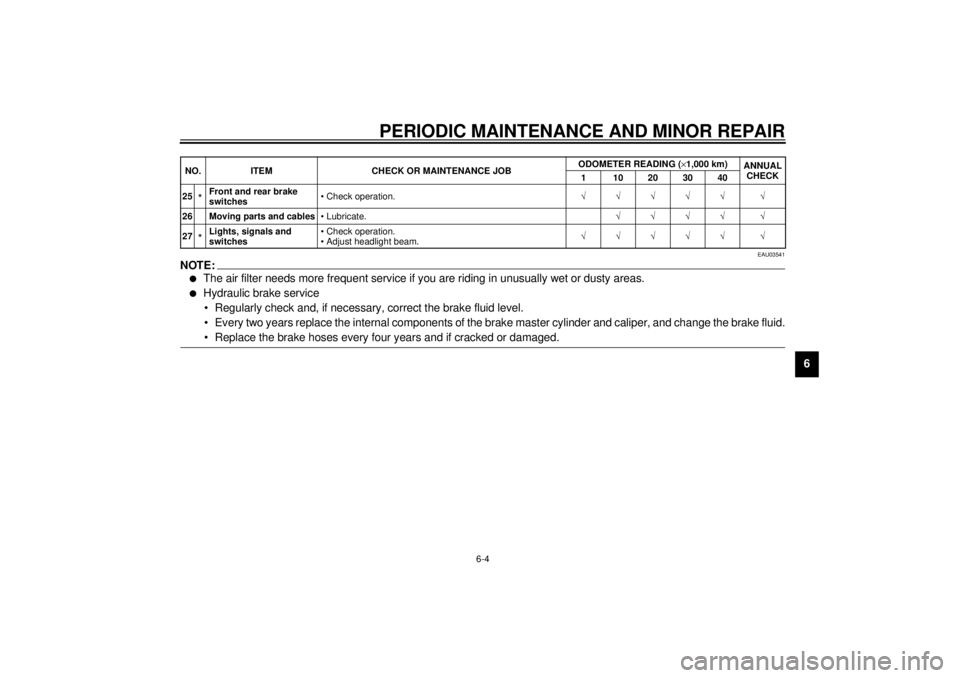
PERIODIC MAINTENANCE AND MINOR REPAIR
6-4
6
EAU03541
NOTE:@l
The air filter needs more frequent service if you are riding in unusually wet or dusty areas.
l
Hydraulic brake service
• Regularly check and, if necessary, correct the brake fluid level.
• Every two years replace the internal components of the brake master cylinder and caliper, and change the brake fluid.
• Replace the brake hoses every four years and if cracked or damaged.
@25
*Front and rear brake
switches• Check operation.ÖÖÖÖÖ Ö
26 Moving parts and cables• Lubricate.ÖÖÖÖ Ö
27*Lights, signals and
switches• Check operation.
• Adjust headlight beam.ÖÖÖÖÖ Ö NO. ITEM CHECK OR MAINTENANCE JOBODOMETER READING (´1,000 km)
ANNUAL
CHECK
1 10203040
E_4km.book Page 4 Thursday, September 7, 2000 9:32 AM
Page 64 of 100
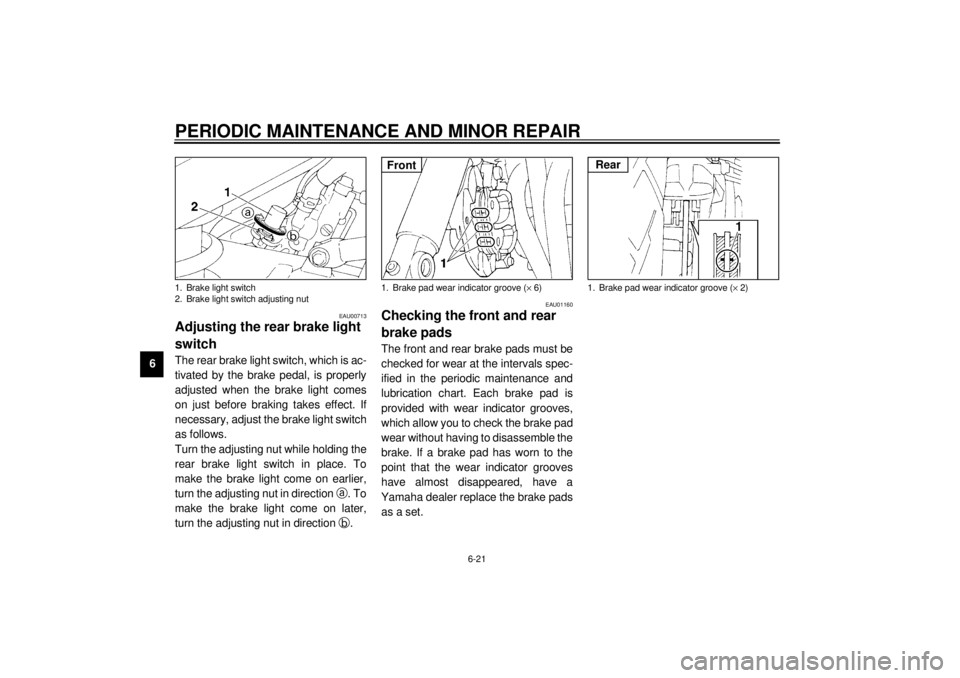
PERIODIC MAINTENANCE AND MINOR REPAIR
6-21
6
EAU00713
Adjusting the rear brake light
switch The rear brake light switch, which is ac-
tivated by the brake pedal, is properly
adjusted when the brake light comes
on just before braking takes effect. If
necessary, adjust the brake light switch
as follows.
Turn the adjusting nut while holding the
rear brake light switch in place. To
make the brake light come on earlier,
turn the adjusting nut in direction
a. To
make the brake light come on later,
turn the adjusting nut in direction
b.
EAU01160
Checking the front and rear
brake pads The front and rear brake pads must be
checked for wear at the intervals spec-
ified in the periodic maintenance and
lubrication chart. Each brake pad is
provided with wear indicator grooves,
which allow you to check the brake pad
wear without having to disassemble the
brake. If a brake pad has worn to the
point that the wear indicator grooves
have almost disappeared, have a
Yamaha dealer replace the brake pads
as a set.
1. Brake light switch
2. Brake light switch adjusting nut
1. Brake pad wear indicator groove (´ 6)Front
1. Brake pad wear indicator groove (´ 2)Rear
E_4km.book Page 21 Thursday, September 7, 2000 9:32 AM
Page 77 of 100
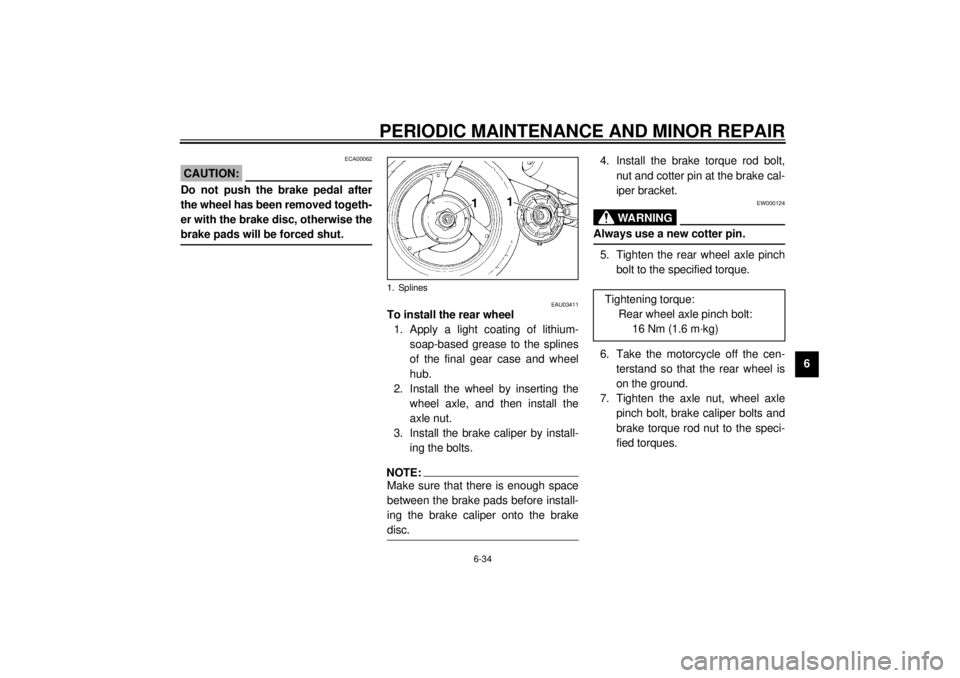
PERIODIC MAINTENANCE AND MINOR REPAIR
6-34
6
ECA00062
CAUTION:@ Do not push the brake pedal after
the wheel has been removed togeth-
er with the brake disc, otherwise the
brake pads will be forced shut. @
EAU03411
To install the rear wheel
1. Apply a light coating of lithium-
soap-based grease to the splines
of the final gear case and wheel
hub.
2. Install the wheel by inserting the
wheel axle, and then install the
axle nut.
3. Install the brake caliper by install-
ing the bolts.NOTE:@ Make sure that there is enough space
between the brake pads before install-
ing the brake caliper onto the brake
disc. @
4. Install the brake torque rod bolt,
nut and cotter pin at the brake cal-
iper bracket.
EW000124
WARNING
@ Always use a new cotter pin. @5. Tighten the rear wheel axle pinch
bolt to the specified torque.
6. Take the motorcycle off the cen-
terstand so that the rear wheel is
on the ground.
7. Tighten the axle nut, wheel axle
pinch bolt, brake caliper bolts and
brake torque rod nut to the speci-
fied torques.
1. Splines
Tightening torque:
Rear wheel axle pinch bolt:
16 Nm (1.6 m·kg)
E_4km.book Page 34 Thursday, September 7, 2000 9:32 AM
Page 83 of 100
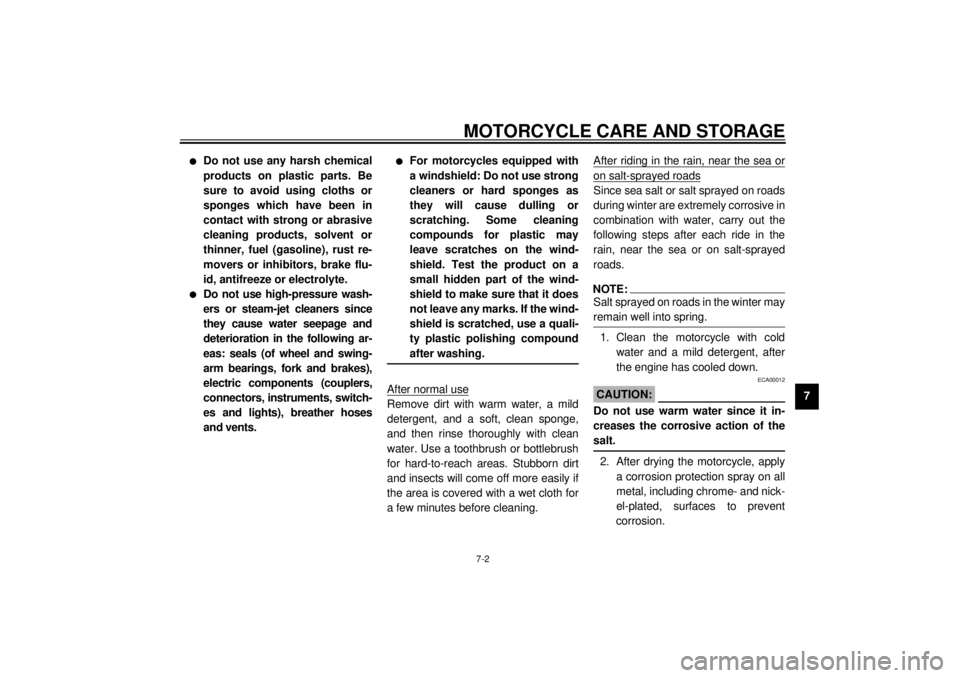
MOTORCYCLE CARE AND STORAGE
7-2
7
l
Do not use any harsh chemical
products on plastic parts. Be
sure to avoid using cloths or
sponges which have been in
contact with strong or abrasive
cleaning products, solvent or
thinner, fuel (gasoline), rust re-
movers or inhibitors, brake flu-
id, antifreeze or electrolyte.
l
Do not use high-pressure wash-
ers or steam-jet cleaners since
they cause water seepage and
deterioration in the following ar-
eas: seals (of wheel and swing-
arm bearings, fork and brakes),
electric components (couplers,
connectors, instruments, switch-
es and lights), breather hoses
and vents.
l
For motorcycles equipped with
a windshield: Do not use strong
cleaners or hard sponges as
they will cause dulling or
scratching. Some cleaning
compounds for plastic may
leave scratches on the wind-
shield. Test the product on a
small hidden part of the wind-
shield to make sure that it does
not leave any marks. If the wind-
shield is scratched, use a quali-
ty plastic polishing compound
after washing.
@After normal useRemove dirt with warm water, a mild
detergent, and a soft, clean sponge,
and then rinse thoroughly with clean
water. Use a toothbrush or bottlebrush
for hard-to-reach areas. Stubborn dirt
and insects will come off more easily if
the area is covered with a wet cloth for
a few minutes before cleaning.After riding in the rain, near the sea or
on salt-sprayed roadsSince sea salt or salt sprayed on roads
during winter are extremely corrosive in
combination with water, carry out the
following steps after each ride in the
rain, near the sea or on salt-sprayed
roads.NOTE:@ Salt sprayed on roads in the winter may
remain well into spring. @1. Clean the motorcycle with cold
water and a mild detergent, after
the engine has cooled down.
ECA00012
CAUTION:@ Do not use warm water since it in-
creases the corrosive action of the
salt. @2. After drying the motorcycle, apply
a corrosion protection spray on all
metal, including chrome- and nick-
el-plated, surfaces to prevent
corrosion.
E_4km.book Page 2 Thursday, September 7, 2000 9:32 AM